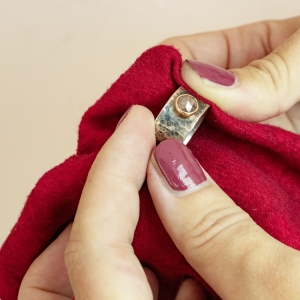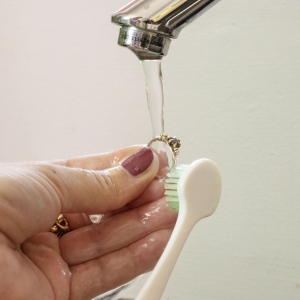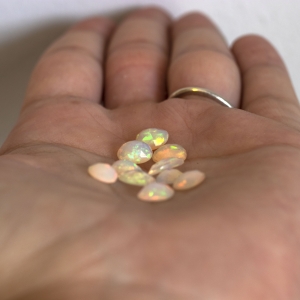Silver & Gold
All Izao’s jewelry is made from sterling silver (925) and gold, 14 or 18kt.
Silver may tarnish over time due to oxidization, a natural phenomenon. It’s best to just wear your jewelry so it doesn’t get the chance to turn black, however, if you don’t wear your silver every day, store it in a air tight container. You could use a little plastic zip bag and keep it in it’s original box.
If your silver has already tarnished, no need to worry, you can wash it with luke warm water and soap, gently brush it with a soft brush to remove any build-up. Afterwards, dry thoroughly with a soft flannel or cotton cloth. Don’t let it air dry as water could leave some spots.
Avoid contact with body lotion, creams, perfume and all kinds of alcohol. It’s also best to take your jewelry off when sleeping.


Gemstones care
Gemstones are mother nature’s little treasures. All the gems used are natural but can be treated. Heating for color enhancing is very common.
I use a lot of gems with inclusions which are a proof of Natures work and I think it often gives character to a piece.
Nevertheless, you should always wear your gemstones carefully.
The gemstones I use are hard enough to be worn as jewelry but they can wear out over time.
To keep your stones bright and shiny, avoid wearing them while gardening, building, moving stuff etc…
Also try no to drop your jewelry! Even Diamonds (the hardest material on earth) could break, so be a little careful and handle your precious treasure with love.
To clean your gemstones, brush them gently with a soft brush (like an old tooth brush), under luke warm water and a dash of dish soap. Avoid contact with any chemicals.
If you’re the owner of a little ultrason cleaning device you could use it for most gemstones however, never use it for Opals, Emeralds, Onyx, Lapis lazuli, Coral and Amber ( or any other porous kind).
Opals, the little unicorns of gems
Opals are a little different than most gemstones, especially Welo (Ethiopia) mined ones. Here’s why.
The play of color you see in Opal is due to millions of tiny silica Spheres of different sizes. These spheres refract light and cause the beautiful spectral colors you see in an opal. Chemically speaking, opal is a form of hydrated silica. Unlike most gemstones, opal isn’t crystalline. That means the silica doesn’t form in a nice, neat crystal structure. Instead, it forms as microscopic, amorphous spheres. Think of opal micro-structure as more like balls of yarn than interlocking toy bricks. (https://www.hubertgem.com)
Because of this, Opals can be brittle, sillica may be quite hard but the way the crystals holds together makes them somewhat breakable.
Ethiopian Opals (Welo) are hydrophane, when soaked in water they absorb it and become transparent. They will get their color back after a few hours but avoid water around them!


